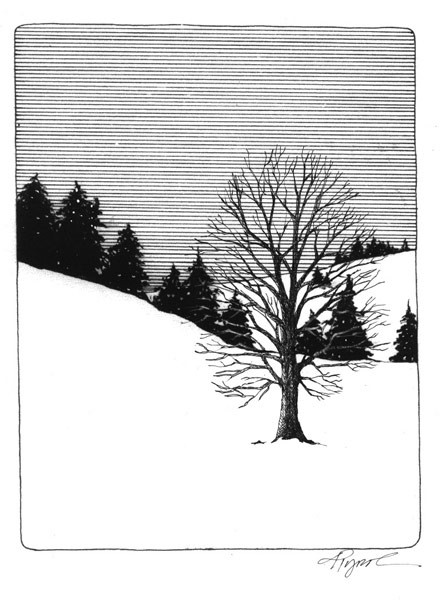
Snow: Love it if you ski, but hate it if you have a long driveway.
I happen to cross-country ski and like lots of snow, and so far, two weeks into the new winter, I have few complaints. Maybe it will be as good as last year.
But wait: Was last year, in fact, a heavy snow season? Actually, it depends on how you look at the numbers.
Many sites in the region set or came close to records in the winter of 2007-08. But it’s important to consider what we mean by “record.”
The most widely reported measurement of snow is a running tally of snowfall. All the news reports stating that the winter of 2007-08 was a near-record year refer only to this metric. With this measurement, the number of inches increases with each accumulating event. Nothing is subtracted. That means that any melting between snowfalls from rain or sunshine isn’t factored in. By this method, Concord, N.H., came within a whisker of the 122-inch record set in the winter of 1874, and St. Johnsbury, VT, surpassed its 130-inch record set in 1894. This measure of snowfall may be a good gauge for how much shoveling (or snow-blowing) you did, but in terms of how the snowfall affects natural systems it is not the best.
Two other methods can be used to describe the snow season, and by both, last winter looked much more typical. One method measures how much snow lies on the ground (snowpack depth) at a particular point in time, and the other records how long the snow lies there (snow-cover days). In many ways snowpack depth and snow-cover days matter more to natural systems than how much snow falls from the sky.
Snow insulates the ground and keeps it from freezing deeply, so how thick this insulation is and how long it is there affects the lives of most organisms below the surface. Small animals that live in and near the ground experience a relatively warm and consistent 32 degrees F. environment under a deep snowpack. Larger animals, like deer and moose, must expend energy to move through the snow, which means they can be more adversely affected by snow pack depth and duration than by how much falls from the clouds.
Nutrients, particularly biologically crucial nitrogen, cycle differently in frozen and unfrozen soils, and how they cycle has repercussions for both plant nutrition and stream chemistry. For example, when the ground freezes, needle ice forms in the soils and cuts into roots like a knife. When things start moving again in the spring thaw, nitrogen becomes available to plants, yet the damaged root systems are less able to take this nitrogen up, and it is washed off into brooks and streams. This adds to the amount of nitrogen pollution that spikes in our waterways each spring. If the ground remains thawed under a deep snowpack, however, much of this nitrogen is taken up by plants and does not enter waterways.
A running tally of snowfall doesn’t describe how plants and streams might be affected by too many or not enough nutrients. By the other two measurements, the more ecosystem-relevant measurements, last winter was snowy, but not close to any records.
Let’s consider some numbers:
At least two sites in our region, Mt. Mansfield in Vermont and the Hubbard Brook Experimental Forest in New Hampshire, have snowpack measurements spanning more than a half century. The record snow depth at the Mt. Mansfield weather station (elevation 3,900 feet) currently stands at 149 inches and was set in 1969. Last year a 110-inch depth was recorded; but since measurements began in 1954, at least eight years exceeded that depth.
The average duration of continuous snow cover on Mt. Mansfield has been 188 days. Last winter came in at 204 days, but the statistic was hardly remarkable considering that it was one of 18 years that surpassed 200 days. At least for high elevations in the Green Mountains, it is safe to say that last winter was snowy but well within the 50-year range of observations.
Like Mt. Mansfield, the maximum snowpack depth at Hubbard Brook in 2008 was above average at 39 inches, but nowhere near the 55-inch record set in 1970. Similarly, the duration of snow cover, at 131 days, was above average, yet last year was only among the top 14 years. It was a full month shorter than the record year set in 1972.
A glance at the data from both sites reveals very high variability from year to year, which probably isn’t news to anyone who has lived in the region for a long time. Despite the variability, the data at Hubbard Brook does show one interesting trend: There has been a significant decline in both the duration of snow cover and the maximum depth at the experimental forest since the records began. The maximum snow depth has been declining at a rate of about 1.8 inches every 10 years, and the duration of the snowpack has declined by 23 days since 1955. (No such trends are evident at the higher elevations of Mt. Mansfield.)
This general decline in snowpack duration and depth over the years at lower elevations at Hubbard Brook is not encouraging for snow lovers in that area. Over the long term, it suggests possible changes to ecosystems. However, the variability is enough for me to remain hopeful. With variability, there’s always a chance to hit the skiing jackpot.


Discussion *